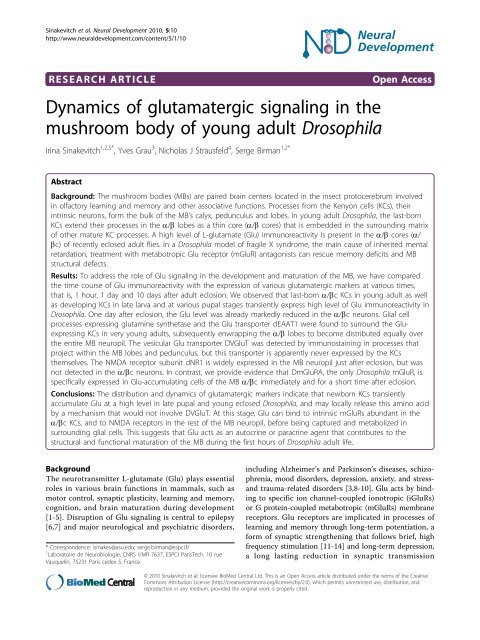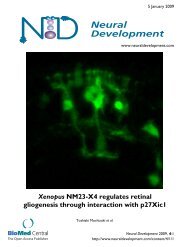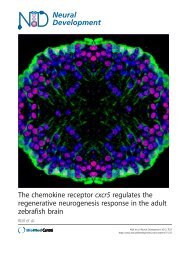Dynamics of glutamatergic signaling in the mushroom ... - HAL - ESPCI
Dynamics of glutamatergic signaling in the mushroom ... - HAL - ESPCI
Dynamics of glutamatergic signaling in the mushroom ... - HAL - ESPCI
Create successful ePaper yourself
Turn your PDF publications into a flip-book with our unique Google optimized e-Paper software.
S<strong>in</strong>akevitch et al. Neural Development 2010, 5:10<br />
http://www.neuraldevelopment.com/content/5/1/10<br />
RESEARCH ARTICLE<br />
Open Access<br />
<strong>Dynamics</strong> <strong>of</strong> <strong>glutamatergic</strong> <strong>signal<strong>in</strong>g</strong> <strong>in</strong> <strong>the</strong><br />
<strong>mushroom</strong> body <strong>of</strong> young adult Drosophila<br />
Ir<strong>in</strong>a S<strong>in</strong>akevitch 1,2,5* , Yves Grau 3 , Nicholas J Strausfeld 4 , Serge Birman 1,2*<br />
Abstract<br />
Background: The <strong>mushroom</strong> bodies (MBs) are paired bra<strong>in</strong> centers located <strong>in</strong> <strong>the</strong> <strong>in</strong>sect protocerebrum <strong>in</strong>volved<br />
<strong>in</strong> olfactory learn<strong>in</strong>g and memory and o<strong>the</strong>r associative functions. Processes from <strong>the</strong> Kenyon cells (KCs), <strong>the</strong>ir<br />
<strong>in</strong>tr<strong>in</strong>sic neurons, form <strong>the</strong> bulk <strong>of</strong> <strong>the</strong> MB’s calyx, pedunculus and lobes. In young adult Drosophila, <strong>the</strong> last-born<br />
KCs extend <strong>the</strong>ir processes <strong>in</strong> <strong>the</strong> a/b lobes as a th<strong>in</strong> core (a/b cores) that is embedded <strong>in</strong> <strong>the</strong> surround<strong>in</strong>g matrix<br />
<strong>of</strong> o<strong>the</strong>r mature KC processes. A high level <strong>of</strong> L-glutamate (Glu) immunoreactivity is present <strong>in</strong> <strong>the</strong> a/b cores (a/<br />
bc) <strong>of</strong> recently eclosed adult flies. In a Drosophila model <strong>of</strong> fragile X syndrome, <strong>the</strong> ma<strong>in</strong> cause <strong>of</strong> <strong>in</strong>herited mental<br />
retardation, treatment with metabotropic Glu receptor (mGluR) antagonists can rescue memory deficits and MB<br />
structural defects.<br />
Results: To address <strong>the</strong> role <strong>of</strong> Glu <strong>signal<strong>in</strong>g</strong> <strong>in</strong> <strong>the</strong> development and maturation <strong>of</strong> <strong>the</strong> MB, we have compared<br />
<strong>the</strong> time course <strong>of</strong> Glu immunoreactivity with <strong>the</strong> expression <strong>of</strong> various <strong>glutamatergic</strong> markers at various times,<br />
that is, 1 hour, 1 day and 10 days after adult eclosion. We observed that last-born a/bc KCs <strong>in</strong> young adult as well<br />
as develop<strong>in</strong>g KCs <strong>in</strong> late larva and at various pupal stages transiently express high level <strong>of</strong> Glu immunoreactivity <strong>in</strong><br />
Drosophila. One day after eclosion, <strong>the</strong> Glu level was already markedly reduced <strong>in</strong> <strong>the</strong> a/bc neurons. Glial cell<br />
processes express<strong>in</strong>g glutam<strong>in</strong>e syn<strong>the</strong>tase and <strong>the</strong> Glu transporter dEAAT1 were found to surround <strong>the</strong> Gluexpress<strong>in</strong>g<br />
KCs <strong>in</strong> very young adults, subsequently enwrapp<strong>in</strong>g <strong>the</strong> a/b lobes to become distributed equally over<br />
<strong>the</strong> entire MB neuropil. The vesicular Glu transporter DVGluT was detected by immunosta<strong>in</strong><strong>in</strong>g <strong>in</strong> processes that<br />
project with<strong>in</strong> <strong>the</strong> MB lobes and pedunculus, but this transporter is apparently never expressed by <strong>the</strong> KCs<br />
<strong>the</strong>mselves. The NMDA receptor subunit dNR1 is widely expressed <strong>in</strong> <strong>the</strong> MB neuropil just after eclosion, but was<br />
not detected <strong>in</strong> <strong>the</strong> a/bc neurons. In contrast, we provide evidence that DmGluRA, <strong>the</strong> only Drosophila mGluR, is<br />
specifically expressed <strong>in</strong> Glu-accumulat<strong>in</strong>g cells <strong>of</strong> <strong>the</strong> MB a/bc immediately and for a short time after eclosion.<br />
Conclusions: The distribution and dynamics <strong>of</strong> <strong>glutamatergic</strong> markers <strong>in</strong>dicate that newborn KCs transiently<br />
accumulate Glu at a high level <strong>in</strong> late pupal and young eclosed Drosophila, and may locally release this am<strong>in</strong>o acid<br />
by a mechanism that would not <strong>in</strong>volve DVGluT. At this stage, Glu can b<strong>in</strong>d to <strong>in</strong>tr<strong>in</strong>sic mGluRs abundant <strong>in</strong> <strong>the</strong><br />
a/bc KCs, and to NMDA receptors <strong>in</strong> <strong>the</strong> rest <strong>of</strong> <strong>the</strong> MB neuropil, before be<strong>in</strong>g captured and metabolized <strong>in</strong><br />
surround<strong>in</strong>g glial cells. This suggests that Glu acts as an autocr<strong>in</strong>e or paracr<strong>in</strong>e agent that contributes to <strong>the</strong><br />
structural and functional maturation <strong>of</strong> <strong>the</strong> MB dur<strong>in</strong>g <strong>the</strong> first hours <strong>of</strong> Drosophila adult life.<br />
Background<br />
The neurotransmitter L-glutamate (Glu) plays essential<br />
roles <strong>in</strong> various bra<strong>in</strong> functions <strong>in</strong> mammals, such as<br />
motor control, synaptic plasticity, learn<strong>in</strong>g and memory,<br />
cognition, and bra<strong>in</strong> maturation dur<strong>in</strong>g development<br />
[1-5]. Disruption <strong>of</strong> Glu <strong>signal<strong>in</strong>g</strong> is central to epilepsy<br />
[6,7] and major neurological and psychiatric disorders,<br />
* Correspondence: is<strong>in</strong>akev@asu.edu; serge.birman@espci.fr<br />
1 Laboratoire de Neurobiologie, CNRS UMR 7637, <strong>ESPCI</strong> ParisTech, 10 rue<br />
Vauquel<strong>in</strong>, 75231 Paris cedex 5, France<br />
<strong>in</strong>clud<strong>in</strong>g Alzheimer’s and Park<strong>in</strong>son’s diseases, schizophrenia,<br />
mood disorders, depression, anxiety, and stressand<br />
trauma-related disorders [3,8-10]. Glu acts by b<strong>in</strong>d<strong>in</strong>g<br />
to specific ion channel-coupled ionotropic (iGluRs)<br />
or G prote<strong>in</strong>-coupled metabotropic (mGluRs) membrane<br />
receptors. Glu receptors are implicated <strong>in</strong> processes <strong>of</strong><br />
learn<strong>in</strong>g and memory through long-term potentiation, a<br />
form <strong>of</strong> synaptic streng<strong>the</strong>n<strong>in</strong>g that follows brief, high<br />
frequency stimulation [11-14] and long-term depression,<br />
a long last<strong>in</strong>g reduction <strong>in</strong> synaptic transmission<br />
© 2010 S<strong>in</strong>akevitch et al; licensee BioMed Central Ltd. This is an Open Access article distributed under <strong>the</strong> terms <strong>of</strong> <strong>the</strong> Creative<br />
Commons Attribution License (http://creativecommons.org/licenses/by/2.0), which permits unrestricted use, distribution, and<br />
reproduction <strong>in</strong> any medium, provided <strong>the</strong> orig<strong>in</strong>al work is properly cited.




